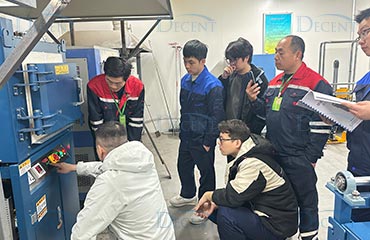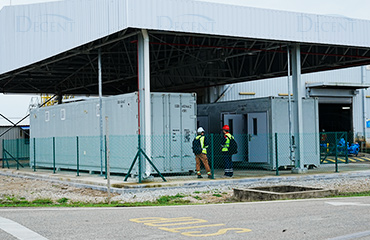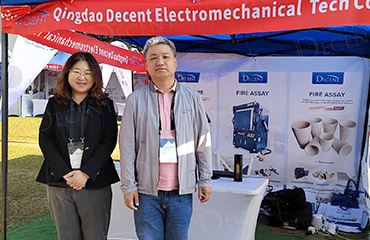Application of Mobile Containers in the Mineral Industry
Unlocking the Future: Mobile Containers in Mineral Exploration
Introduction
With the continuous development of the mineral industry, technological innovation is profoundly changing our understanding of resource exploration, extraction, and analysis. In this trend, mobile containers, as a striking solution, are gradually becoming a key element in the mining sector. The introduction of mobile container technology brings unprecedented flexibility, convenience, and efficiency to the mineral industry, offering new methods for on-site analysis, exploration, storage, laboratory testing, and data management among diverse needs.
Background: Mobile Containers and Their Applications in Different Industries
As an innovative technological solution, mobile containers have gained prominence in various industries, injecting new vitality and efficiency into traditional business models. The core concept involves integrating traditional laboratories, testing equipment, or analytical tools into portable container structures, enabling the mobility and instant deployment of equipment. This concept has had far-reaching effects in multiple fields, including the mineral sector.
Applications of Mobile Containers in Various Industries
The flexibility and versatility of mobile containers have led to their widespread use in different sectors such as healthcare, environmental monitoring, agriculture, and food safety. For instance, in the healthcare sector, mobile medical laboratories can be rapidly deployed to remote areas to support medical services. In environmental monitoring, mobile laboratories can swiftly respond to sudden environmental events for pollutant detection and monitoring. In agriculture and food safety, mobile containers can be used for rapid testing of soil quality, crop contamination, and food composition, ensuring food safety and sustainable agricultural practices.
These application cases showcase the adaptability and versatility of mobile containers. Through the functionality of mobile laboratories, this solution addresses challenges posed by lengthy construction cycles, high costs, and location-specific limitations of traditional facilities. Its rapid deployment capability makes it an ideal choice for addressing emergencies, unexpected events, and temporary demands.
In the mineral industry, the application of mobile containers also presents significant potential and prospects. Mineral exploration, extraction, and analysis involve frequent on-site operations, and mobile containers can provide real-time laboratory support for these activities. Additionally, mineral resources are distributed widely, and the flexibility of mobile containers enables them to adapt to various geographical environments and challenges. Therefore, the application of mobile containers in the mineral sector is poised to bring higher efficiency, faster response times, and more accurate data analysis capabilities to mining enterprises.
Mobile Container Technology and Its Features
As an innovative solution, mobile container technology has rapidly gained prominence in various fields. Its unique technical features give it a wide range of potential applications in sectors such as the mineral industry.
A. Definition and Structure
A mobile container is a portable container solution that integrates laboratories, instrument equipment, and other analytical tools. Typically, these mobile containers are based on shipping standard containers, ensuring convenience during transportation, stacking, and deployment processes. The structure and composition materials of shipping containers are suitable for a wide range of application areas and can also be customized and improved to meet specific and unique requirements of different industries.
B. Technical Features- Portability and Flexibility: One of the primary characteristics of mobile containers is their high portability. They can be swiftly relocated and deployed to different locations to accommodate the requirements of various projects and tasks. This flexibility provides robust support for activities like mineral exploration and extraction, which necessitate frequent mobility.
- Adaptability and Versatility: Mobile containers can be customized according to different application needs, thus possessing versatility. They can integrate various equipment such as analytical instruments, experimental tools, and data processing systems to meet diverse laboratory and testing requirements.
- Rapid Deployment Capability: The design of mobile containers enables them to be quickly put into use. Whether for on-site exploration, environmental monitoring, or laboratory testing, their rapid deployment capability helps reduce waiting times, accelerate data acquisition, and expedite the data analysis process.
Application of Mobile Containers in Mineral Exploration and Extraction
A. On-Site Exploration and Analysis
Mobile containers hold immense potential for applications in mineral exploration. Exploration activities often require rapid acquisition of information about geological formations and ore composition. By housing various analytical instruments such as X-ray fluorescence spectrometers and spectrometers, mobile containers enable on-site ore composition analysis. This capability allows exploration teams to swiftly obtain critical data, reducing waiting times for sample analysis, optimizing exploration plans, and supporting decision-making.
B. Rapid Decision Support
In the process of mineral extraction, the on-site analysis capability of mobile containers is crucial for swift decision-making. Challenges such as different ore types and variations in quality may arise during the extraction process, necessitating real-time adjustments to extraction plans. Mobile containers can swiftly analyze collected ore samples, providing real-time data to operators, enabling them to promptly adjust extraction parameters and strategies, thus optimizing production efficiency.
C. Resource Optimization and Savings
The application of mobile containers can reduce the transportation and analysis cycles of samples. Traditionally, collected samples might need to be transported to distant laboratories away from the extraction site for analysis, consuming time and resources. However, the analytical equipment integrated within mobile containers allows analysis to be conducted on-site, saving time and costs associated with sample transportation.
D. Adaptation to Various Geographic Environments
Mineral resources are distributed across diverse geographic environments, some of which might be far from urban areas and laboratory facilities. The portability of mobile containers enables them to easily tackle various geographical challenges. Whether in remote mountainous regions, deserts, or remote areas, mobile containers can provide laboratory-level analysis and testing capabilities, offering robust support for mineral exploration and extraction.
Role of Mobile Containers in Mineral Laboratories
A. Application and Advantages of the Technology
The application of mobile container technology in mineral laboratories is rapidly expanding, bringing flexibility, convenience, and efficiency solutions to mining enterprises. These containers not only offer laboratory-level equipment and functionalities but can also be swiftly deployed to required locations, providing novel methods for mineral analysis and testing.
B. Versatile Equipment Configuration
The internal equipment configuration of mobile containers can be customized according to the specific needs of the laboratory. They can cover tasks ranging from sampling, sample preparation, physical property testing, chemical composition analysis, and more. They can house various experimental and analytical devices, such as jaw crushers, pulverizers, sample dividers, fusion furnaces, cupellation furnaces, spectrometers, mass spectrometers, analysis platforms, and laboratory instruments, catering to different types of ore analysis, component detection, and experimental requirements.
C. Advantages of On-Site Analysis and Testing
Traditional mineral laboratories typically involve ore sample analysis, composition testing, and experimental operations. However, these activities might require samples to be transported to central laboratories far from the mining site for analysis, incurring time and resource costs. Through the application of mobile containers, laboratory functionality can be swiftly brought to the field, enabling real-time analysis and testing. This on-site analysis capability is crucial for timely decision-making and problem-solving.
D. Convenience of Data Management and Transmission
The internal equipment of mobile containers often comes equipped with data transmission and storage systems. Analytical data can be transmitted to central databases or the cloud via high-speed data transfer interfaces after being collected on-site, facilitating data sharing and remote access. This data management and transmission capability assists mining enterprises in better integrating data resources, thereby supporting decision-making.
Technical Challenges and Innovative Solutions
Despite the broad prospects of mobile container technology in the mineral industry, there are still several technical challenges that need to be addressed. These challenges include equipment stability, data transmission, environmental adaptability, and more. However, through innovative solutions, these challenges can be overcome.
A. Technical Challenges
- Equipment Stability and Accuracy: The equipment within mobile containers needs to operate in unstable environments, potentially affected by factors such as temperature, humidity, and vibrations, which can impact the accuracy and reliability of the equipment.
- Data Transmission and Security: Real-time analysis data transmission to central databases or the cloud may involve issues of data transfer speed and data security. Ensuring the integrity and security of data during transmission is a challenge.
- Environmental Adaptability: Mobile containers need to adapt to various geographic and environmental conditions, involving challenges related to power supply, communication connectivity, and equipment protection.
- Maintenance and Support: Deploying and using mobile containers in different locations may require remote support and maintenance, such as equipment updates and troubleshooting.
B. Innovative Solutions
- Enhancing Technical Stability and Accuracy: By using stable equipment and sensors within the mobile container, the impact of environmental changes on equipment accuracy can be minimized. Additionally, through calibration and regular maintenance, equipment accuracy can be maintained consistently.
- Strengthening Data Transmission and Security: Utilizing high-speed data transmission technologies such as satellite connections or 4G networks ensures rapid transmission of real-time data. Meanwhile, employing encryption and secure transmission protocols guarantees data security during transmission and storage.
- Improving Environmental Adaptability: Designing containers to adapt to different environmental conditions by providing features like dust-proofing, moisture-proofing, and insulation. Renewable energy sources and backup power can be used to ensure stable power supply.
- Remote Maintenance and Support: Offering remote monitoring and maintenance services allows for remote monitoring, updates, and troubleshooting of equipment through remote connections, thereby reducing maintenance costs and delays.
Sustainable Development and Future Outlook
The application of mobile container technology in the mineral industry not only enhances efficiency and operational optimization but also has a profound impact on the sustainable development of mining. Introducing this technology provides mining enterprises with more flexible solutions, aiding in reducing environmental impacts, optimizing resource utilization, and creating more sustainable mineral development patterns for the future.
A. Key Aspects of Sustainable Development
- Resource Optimization: Mobile container technology allows for real-time analysis and testing on-site, reducing sample transportation and waiting times, thereby maximizing resource utilization. This helps avoid unnecessary resource wastage and improves resource efficiency.
- Reduced Environmental Impact: By conducting on-site analysis and testing, mobile containers minimize sample transportation, thus lowering carbon emissions and environmental impacts. Additionally, they can work in remote areas, reducing interference with the ecological environment.
- Time and Cost Savings: Mobile container technology enables swift on-site analysis and testing, shortening the data acquisition and analysis cycle. This aids in accelerating decision-making, reducing extraction time, and cutting costs.
B. Future Outlook
- Technological Evolution: As technology advances, the equipment within mobile containers will become more sophisticated, stable, and intelligent. This will further enhance the accuracy of analysis and testing and expand its application scope in the mineral sector.
- Automation and Artificial Intelligence: In the future, mobile containers might integrate with automation technology and artificial intelligence, achieving a higher level of automated analysis and decision-making. This will contribute to increased operational efficiency and faster data processing.
- Sustainable Mining Development: As global demand for sustainable development continues to rise, mobile container technology is poised to become one of the key factors driving the mining industry towards greater sustainability. It can assist mining enterprises in better balancing economic, social, and environmental factors.
Conclusion
Mobile container technology, as an innovative solution, brings rich opportunities and potential to the mineral industry. In mineral exploration and extraction, mobile containers provide more efficient, flexible, and accurate operational modes through functionalities such as on-site analysis, rapid decision support, and resource optimization. Their adaptability and versatility allow ore analysis, component detection, and experimental operations to be swiftly conducted on-site, speeding up decision-making, optimizing production processes, and enhancing resource utilization efficiency. However, along with these advantages, come technical challenges such as equipment stability, data transmission, and environmental adaptability, which also require innovative solutions.
Despite these challenges, the future outlook for mobile container technology remains promising. As technology advances, the intelligence and automation of equipment will further enhance its value. It's anticipated to expand its applications across various fields, providing laboratory support and analytical solutions to different industries.
In conclusion, the prospects of mobile container technology in the mineral industry are extensive. It not only brings higher efficiency and flexibility to mining enterprises but also injects new momentum into the industry's sustainable development. With continued technological progress and innovation driving it forward, mobile containers will continue to play a crucial role in the mineral sector, contributing to a more intelligent and sustainable future. By reducing resource wastage, lowering environmental impact, and enhancing operational efficiency, mobile container technology will create a greener and more efficient approach to mineral development.
 Languages
Languages 中文
中文 English
English Español
Español Pусский
Pусский Deutsch
Deutsch العربية
العربية



